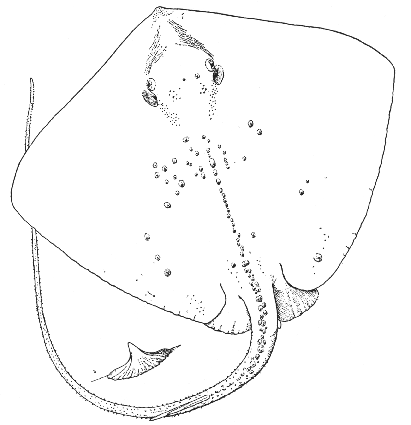Sting ray Dasyatis centroura (Mitchill) 1815 [80]
STINGAREE; CLAM CRACKER
[Bigelow and Schroeder, 1953, p. 352.]
[Garman, 1913, pl. 33, figs. 1, 2, as Dasybatus marinus.]

Figure 32.—Sting ray (Dasyatis centroura), male, about 55½ inches wide, Woods Hole, Massachusetts, and tubercle from tail, about 0.7 times natural size. From Bigelow and Schroeder. Drawings by E. N. Fischer.
Description—
The most distinctive features of this sting ray, among other Gulf of Maine fishes, are its very long, whiplash-like tail without dorsal fins, and the long, saw-edged spine or spines with which the upper side of its tail is armed. The disc is rhomboid, about 11/5 to 11/3 times as broad as it is long; the anterior angle is much blunter than a right angle (130-140°); and the tip of the snout projects very little if at all. The anterior margins of the disc are nearly straight, the posterior margins are only slightly convex, and the posterior corners are abruptly rounded or even angular. The tail, measured from the center of the cloaca, is about 2½ times as long as the body from cloaca to snout. The lower side of the tail has a narrow fold of skin extending rearward from below the origin of the tail spine for a distance about as [page 75] long as from its own origin to the cloaca; the upper side of the tail is rounded, except for a low ridge close behind the spine (or spines). The spear-pointed tail spines, of which there are 1, 2, or sometimes 3, are situated well back on the tail. One spine that we examined had about 40 saw teeth on each edge.
Young ones are smooth skinned (except for the tail spines). Larger ones develop 1 to 3 irregular rows of conical tubercles along the midline of the disc, with others on the shoulders as well as on the outer posterior part of the disc, and the tail becomes very rough finally, with conspicuous thorns along its whole length on its upper side, and rearward from abreast of the tail spines on its lower side. The lower side of the disc is smooth.
Large specimens are easily distinguishable from other sting rays of our Atlantic coast by their very thorny tails and by the large tubercles on the outer parts of their discs. Small ones on which the thorns and tubercles have not yet developed, are recognizable by the shape of the disc, combined with the presence of a skin fold on the lower side of the tail but none on the upper side.
Size—
This appears to be the largest sting ray of the western North Atlantic. The greatest [page 76] measured width definitely recorded for it is 5 feet, the greatest measured length 10 feet 3 inches. But some certainly grow considerably larger, for a New Jersey specimen has been reported as nearly 7 feet across; the corresponding length would be 13 to 14 feet, if the tail were intact.
Color—
Fresh caught specimens seen by us at Woods Hole have been dark brownish above with the tail black from the spine rearward; white below.
General range—
Coastal waters of the western Atlantic, from the latitude of Cape Hatteras to Cape Cod; most common from Delaware Bay to the Woods Hole region.
Occurrence in the Gulf of Maine—
The only claim of this sting ray to mention here is that one was reported from Chatham on the outer shore of Cape Cod many years ago, and that it is said to have been seen on the shoaler parts of Georges Bank. It has no real status as a Gulf of Maine fish, appearing there only as a summer straggler from the south, though it is so common near Woods Hole that the fish traps there catch some 400 to 500 of them in ordinary summers.[81]
Beware of handling any skate-like fish with a long, whip-like tail, lest it prove to be a sting ray. The tail spine (brought into action as the tail is lashed to and fro) is a dangerous weapon; and the wounds made by it cause excruciating pain.
[80] This ray was mentioned as Dasybatus marinus and as D. hastatus in the first edition of this book. But the specimens in question all belong to one species, the correct scientific name for which is Dasyatis centroura, proposed by Mitchill in 1815, as Raja centroura.
[81] This estimate is based on our own observations near Woods Hole.